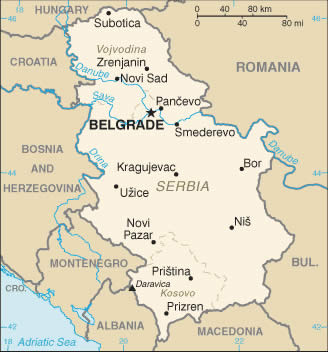Serbia
 Serbia
Serbia
History
The region of Serbia was settled by people that migrated there from the Russian steppes. After their settlement in the Balkans, Serbs formed a medieval kingdom that evolved into a Serbian Empire, which reached its peak in the 14th century. By the 16th century Serbian lands were conquered by the Ottomans. Serbia regained independence from the Ottoman Empire in 1878 and subsequently expanded its territory. Following the end of World War I, the country united with other South Slavic peoples into a Kingdom of Yugoslavia. After the Nazis were pushed out in World War II, communism was established under Josip Broz Tito. But in 1991, communism began to crumble. Deepening economic crisis, ethnic fighting within Yugoslavia and political upheaval sparked civil strife. This ignited tensions with the other republics that eventually resulted in the secession of Slovenia, Croatia, Kosovo, Bosnia and Herzegovina and Macedonia from Yugoslavia leaving only Serbia and Montenegro. In 2006, Montenegro became independent from Serbia. Today the country is officially called the Republic of Serbia.
Church History
Religion is very important to the people of Serbia. It is considered one of their most distinguishing characteristics. Most Serbs are Orthodox, while most Albanians – another ethnic group in Serbia– are Sunni Muslim. Pentecostal believers from the United States and Europe began evangelism and church planting in Serbia in the 1930s. After WWII, contact with believers outside the country was difficult because Christians were “watched” very closely.
The Movement Today
The church survived persecution and ethnic cleansing and emerged even more ready to evangelize. Today, churches are being started throughout the former Yugoslav provinces. People everywhere are seeking peace and freedom from warfare and unrest. They are turning to the Gospel. The Assemblies of God in Serbia report the following statistics: 65 churches, 80 ministers, 9,000 members and adherents. They also have a Bible school called Grace Pentecostal Bible College with 11 students.
Additional Facts About Serbia
- Capital: Belgrade
- Area: 29,913 square miles
- Population: 7.2 million
- Urbanization: 56%
- Ethnic Groups: Serbian 83.3%, Hungarian 3.5%, Romani 2.1%, Bosniak 2%, Others 9.1%
- Languages: Serbian 88%, Hungarian 3.4%, Bosnian 1.9%, Romani 1.4%, Others 5.3%
- Agriculture: Cereals, fruits, and vegetables
- Economy: Steel, machinery, consumer goods, mining, electronics



